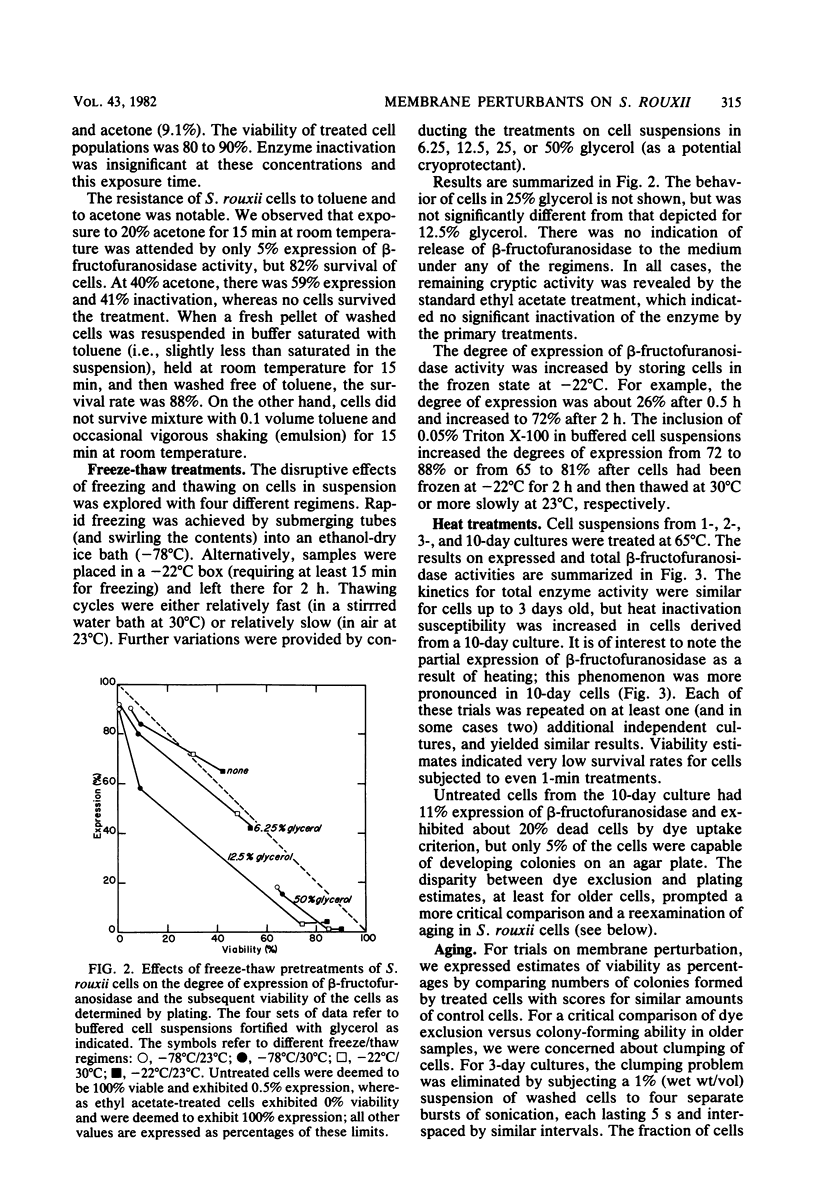Abstract
The osmotolerance of Saccharomyces rouxii 48-28 was confirmed with both NaCl- and KCl-fortified growth media, with more tolerance being exhibited for the potassium salt. Washed and buffered cells from unfortified medium were challenged with a variety of compounds (and also with physical treatments) that potentially would elicit membrane perturbations. The efficacy of these brief treatments was judged primarily by monitoring subsequent viability. Change in the degree of expression of β-fructofuranosidase (EC 3.2.1.26), which is cryptic in young cells of S. rouxii, was a second criterion. There was a linear correlation between cell death and enzyme expression for treatments with polyenes, detergents, some organic solvents which did not denature the enzyme, and various freeze-thaw regimens in graded amounts of glycerol. The species is relatively insensitive to polyene antimycotics, the order of decreasing effect being filipin, nystatin, and amphotericin B. S. rouxii was found to be less sensitive to osmotic shock than is Saccharomyces cerevisiae, but in neither species is β-fructofuranosidase released to the medium. The sensitivity of S. rouxii to ionic detergents, but not to nonionic detergents, was rationalized as being due to cell wall discrimination against larger micelles for the nonionic examples. This was confirmed by showing that protoplasts were sensitive to both classes. In cultures older than 5 days the normal agreement between colony-forming units and methylene blue exclusion (another test of viability) no longer held. Delayed fermentation of sucrose by S. rouxii, which is a diagnostic feature of the species, is explained by death of some cells, expression of their β-fructofuranosidase, and utilization of the monosaccharides by the surviving cells.
Full text
PDF







Selected References
These references are in PubMed. This may not be the complete list of references from this article.
- Arnold W. N. Expression of cryptic beta-fructofuranosidase in Saccharomyces rouxii. J Bacteriol. 1974 Nov;120(2):886–894. doi: 10.1128/jb.120.2.886-894.1974. [DOI] [PMC free article] [PubMed] [Google Scholar]
- Arnold W. N., Garrison R. G., Boyd S. K. Periplasmic structure in Saccharomyces rouxii (Boutroux), an osmophil. Appl Microbiol. 1974 Dec;28(6):1047–1054. doi: 10.1128/am.28.6.1047-1054.1974. [DOI] [PMC free article] [PubMed] [Google Scholar]
- Arnold W. N., Garrison R. G. Isolation and characterization of protoplasts from Saccharomyces rouxii. J Bacteriol. 1979 Mar;137(3):1386–1394. doi: 10.1128/jb.137.3.1386-1394.1979. [DOI] [PMC free article] [PubMed] [Google Scholar]
- Arnold W. N., Lacy J. S. Permeability of the cell envelope and osmotic behavior in Saccharomyces cerevisiae. J Bacteriol. 1977 Aug;131(2):564–571. doi: 10.1128/jb.131.2.564-571.1977. [DOI] [PMC free article] [PubMed] [Google Scholar]
- Arnold W. N. Location of acid phosphatase and -fructofuranosidase within yeast cell envelopes. J Bacteriol. 1972 Dec;112(3):1346–1352. doi: 10.1128/jb.112.3.1346-1352.1972. [DOI] [PMC free article] [PubMed] [Google Scholar]
- Arnold W. N., Pringle A. T., Garrison R. G. Amphotericin B-induced changes in K+ content, viability, and ultrastructure of yeast-phase Histoplasma capsulatum. J Bacteriol. 1980 Jan;141(1):350–358. doi: 10.1128/jb.141.1.350-358.1980. [DOI] [PMC free article] [PubMed] [Google Scholar]
- Carey M. C., Small D. M. Micelle formation by bile salts. Physical-chemical and thermodynamic considerations. Arch Intern Med. 1972 Oct;130(4):506–527. [PubMed] [Google Scholar]
- ENGLISH M. P. Some observations on the physiology of Saccharomyces rouxii Boutroux. J Gen Microbiol. 1954 Apr;10(2):328–336. doi: 10.1099/00221287-10-2-328. [DOI] [PubMed] [Google Scholar]
- Gale E. F., Johnson A. M., Kerridge D., Koh T. Y. Factors affecting the changes in amphotericin sensitivity of Candida albicans during growth. J Gen Microbiol. 1975 Mar;87(1):20–36. doi: 10.1099/00221287-87-1-20. [DOI] [PubMed] [Google Scholar]
- Hamilton-Miller J. M. Chemistry and biology of the polyene macrolide antibiotics. Bacteriol Rev. 1973 Jun;37(2):166–196. [PMC free article] [PubMed] [Google Scholar]
- Helenius A., Simons K. Solubilization of membranes by detergents. Biochim Biophys Acta. 1975 Mar 25;415(1):29–79. doi: 10.1016/0304-4157(75)90016-7. [DOI] [PubMed] [Google Scholar]
- Kaneko H., Hosohara M., Tanaka M., Itoh T. Lipid composition of 30 species of yeast. Lipids. 1976 Dec;11(12):837–844. doi: 10.1007/BF02532989. [DOI] [PubMed] [Google Scholar]
- Koh T. Y. The isolation of obligate osmophilic mutants of the yeast Saccharomyces rouxii. J Gen Microbiol. 1975 May;88(1):184–188. doi: 10.1099/00221287-88-1-184. [DOI] [PubMed] [Google Scholar]
- Miozzari G. F., Niederberger P., Hütter R. Permeabilization of microorganisms by Triton X-100. Anal Biochem. 1978 Oct 1;90(1):220–233. doi: 10.1016/0003-2697(78)90026-x. [DOI] [PubMed] [Google Scholar]
- Munitis M. T., Cabrera E., Rodriguez-Navarro A. An obligate osmophilic yeast from honey. Appl Environ Microbiol. 1976 Sep;32(3):320–323. doi: 10.1128/aem.32.3.320-323.1976. [DOI] [PMC free article] [PubMed] [Google Scholar]
- Norman A. W., Spielvogel A. M., Wong R. G. Polyene antibiotic - sterol interaction. Adv Lipid Res. 1976;14:127–170. [PubMed] [Google Scholar]
- ONISHI H. OSMOPHILIC YEASTS. Adv Food Res. 1963;12:53–94. [PubMed] [Google Scholar]
- PAPPAGIANIS D., PHAFF H. J. Delayed fermentation of sucrose by certain haploid species of Saccharomyces. Antonie Van Leeuwenhoek. 1956;22(4):353–370. doi: 10.1007/BF02538349. [DOI] [PubMed] [Google Scholar]
- Rodréguez-Navarro A. Inhibition by sodium and lithium in osmophilic yeasts. Antonie Van Leeuwenhoek. 1971;37(2):225–231. doi: 10.1007/BF02218485. [DOI] [PubMed] [Google Scholar]
- Scherrer R., Louden L., Gerhardt P. Porosity of the yeast cell wall and membrane. J Bacteriol. 1974 May;118(2):534–540. doi: 10.1128/jb.118.2.534-540.1974. [DOI] [PMC free article] [PubMed] [Google Scholar]
- Tukmachev V. A., Zaslavskii V. Iu, Rogozhin S. V. Membranotropnoe deistvie ionogennykh detergentov na drozhzhevye kletki. Biokhimiia. 1977 Nov;42(11):2058–2063. [PubMed] [Google Scholar]


